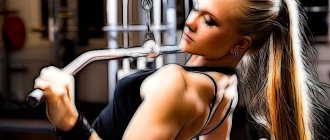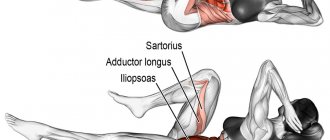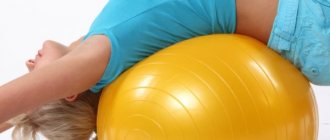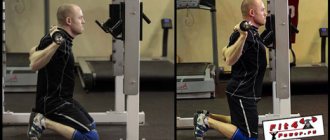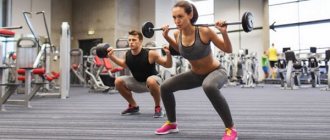Pros and cons of Russian crunches
Pros of the exercise:
- Thanks to the peculiarities of the technique, the exercise trains not only the external abdominal muscles, but also the internal ones, which are responsible for maintaining the spine and the correct position and functioning of the internal organs. Relaxed internal abdominal muscles cannot hold the lower back in the correct position, which causes lumbar hyperlordosis to form.
- The exercise, when performed in large numbers of repetitions, forms a muscle corset, visually improves the shape of the muscles and indirectly helps to reduce waist size, especially with the right loads and nutrition. Exercise itself does not burn fat locally in this area. And lifting weights makes the muscles thicker and more defined.
The disadvantage of the twist is that the oblique twisting technique is not suitable for everyone, namely for problems with the spine - hernia, protrusion, pinched nerve endings, osteochondrosis and displacement of the vertebrae. Even in healthy people, performing a twist incorrectly can cause back pain. Therefore, it should be performed with good physical preparation and master the technique first without weights.
Can Russian crunches really hurt your back?
Some doctors and trainers consider Russian crunches to be a dangerous exercise.
For example, physical therapist Bryce Hastings of the online training resource Les Milles explains The ab exercise to avoid / Les Milles that a semi-sitting position paired with a rounded back compresses the front of the intervertebral discs in the lower back, shifting the fluid contents (nucleus pulposus) from the center back.
In the long term, this can lead to damage to the connective tissue of the disc (annulus fibrosus) and result in back pain.
However, we were unable to find studies confirming the harm of Russian twists for the spine. It can be assumed that if you do the exercise technically correctly, without rounding your back and rotating your lower back, there will be no more harm from it than from slouching at the computer all day long.
And yet, if you have lower back pain or have already had problems with intervertebral discs, you should not perform Russian twists. It’s better to replace them with a side plank - it also pumps up the oblique abdominal muscles well, but does not compress the intervertebral discs.
Russian floor crunch technique
- Starting position: sitting on your buttocks, keep your feet hanging, bending your knees. Lean your body back about 45 degrees, slightly rounding your back. Stretch your arms in front of you, placing your palms together for comfort. This position should be maintained throughout the approach. The main thing is not to lose your balance.
- In the center of the movement, inhale, and exhale, twist your torso to the right at the same time as your arms. Return to the center as you inhale, and exhale as you twist in the opposite direction.
- When performing the movement, take your time and do not rotate your pelvis or legs along with your body. The movement should be performed by the oblique abdominal muscles.
To simplify the technique , lower your heels to the floor with your knees slightly bent.
How else can you do Russian crunches?
There are quite a few variations of Russian crunches that you can use in your workouts for variety and added challenge.
With your hands behind your head
Leave your feet on the floor, place your hands behind your head and twist your body, trying to keep your back straight.
If you want to make the exercise even more challenging, try extending your arms straight above your head and crossing them together.
With alternating knee bending
Frame: 4 Russian twist variations for core strength / Runner's World
Extend your arms in front of you and place your palms together, straighten your back and lift your legs. Turn your body to the right, simultaneously bending your left leg at the knee and leaving your right leg straight. Then turn to the left, reversing the position of your legs.
With a mini rubber band on your hands
Frame: 4 Russian twist variations for core strength / Runner's World
Put the resistance band on your wrists, lower your shoulders and shoulder blades and spread your straight arms, overcoming the resistance of the band. Perform Russian crunches with your feet on the floor without releasing pressure on the expander.
Throwing the ball on the floor
For this variation, you will need a medicine ball filled with sand or a medicine ball.
Get into the starting position for a Russian crunch with your feet on the floor, turn to the side and throw the ball on the floor next to your hip. Catch the rebounding projectile and do the same in the other direction.
Features of the Russian twist with a kettlebell
The twist technique is unchanged, the only difference is the addition of weights. This is necessary at the moment when the muscles have adapted to the load with their own weight and stopped developing.
- To do this, you need to take the weight by the arms on the sides, tilt the body, taking the starting position with your feet off the floor, and twist to the side.
- Carry the weight with your arms bent at the elbows above your body, and when turning, touch the weight to the floor. The same goes in the opposite direction. But you don’t have to lower the weight so low, working with your hands at a level parallel to the floor, the amplitude will be less. The choice of technique depends on the weight of the weight.
Execution options
Russian crunches with legs raised
This is a more complex version of Russian crunches. By lifting our feet off the floor, we lose one of our support points. Therefore, we now need more concentration when performing this exercise. The rectus abdominis muscle will help us keep our legs suspended. So, the load on her will increase. The technique itself will remain the same as in the classic version. As you exhale, turn to one side. Then, from the original position, we rotate the body to another. During movement, the lower part of the body must remain motionless. We perform crunches at an average pace. We work only with the oblique abdominal muscles, and do not forget about the pause at the three points that we talked about above.
Russian crunches with extra weight
As weights, you can use dumbbells, weights, a barbell, etc. Take the equipment that you are comfortable working with. The execution is identical to the classic version. We sit down on the mat. We bend our legs and place our feet on the floor. And we begin to do twists in different directions. It is very important to choose the right weight of training equipment. Otherwise, you simply will not be able to make a turn using only the force of the oblique muscles. And you will begin to include the widest and deltoids in the movement. This technique will not be very effective for developing core muscles. Therefore, there is no point in taking heavy dumbbells or weights. Also, there are some variations of performing crunches with additional weight. 1) Perform the exercise as usual. That is, we take the weight in outstretched arms and do rotations. 2) Now let’s complicate the exercise a little. Place the weight to your right. We make a turn, take it in our hands and shift it to the left side. Then again to the right. And so we shift the weight, from side to side. Try each of the options and find the one that suits you best.
Russian crunches on a fitball
This option is mainly performed in order to reduce the load on the lumbar region. If you have never worked on a fitball, you will have to spend a little time getting used to it. You can do crunches with or without weight. It all depends on your level of preparation. As for the execution technique, the principle is the same. We lie down on the fitball. We round our back a little. We take any weight or work without it. And while exhaling, we perform twisting. For greater stability, spread your feet wider.
Russian crunches while standing with a barbell
This is the strength version of this exercise. It is performed with a barbell. To do this, rest one end of the bar against anything, and hang pancakes on the other. Next, we take the loaded edge of the bar in our hands. We move back a little so that we stand as if at an angle. Such a stand will provide us with greater stability. And we perform the twists that are already familiar to us, from side to side. It is very important to take into account that the oblique muscles, like all others, are subject to hypertrophy. And if you work with more weight, their volume will increase. Consequently, the waist will also become wider. I think many girls would not want this. Therefore, it is better for them to choose options in which the weight of the burden is less or absent altogether.
Features of the Russian twist with pancake
This option is quite convenient if the pancakes have holes on the sides that make it easier to grip.
- You should hold the pancake of the required weight on the sides; of course, its weight should be moderate.
- When twisting, the pancake moves parallel to the floor. The technique and breathing remain the same.
If you've ever looked for ways to strengthen your obliques, you've probably come across the Russian Twist. It has been touted as one of the most effective ways to trim your waist and eliminate your sides... but the risks far outweigh any such benefits.
The Russian Twist is performed like this: sit on the floor, lean your body back and bend your knees to create a v-shape; then twist your torso from side to side. And that's not a good idea.
Bryce Hastings, physiotherapist and head of research at Les Mills, explains what the main problems with the Russian Twist are.
The first issue is compression. Remaining in a half-body sit-up position requires increased contraction of the abdominals and back flexors, which in turn results in excessive compression of the lumbar spine.
The second question is bending . By not resting your back on the floor, you will end up in a bent position as your spine rounds. The combination of compression and end-range flexion produces intense pressure on the spinal discs. In this position, before the vertebrae compress, the posterior lumbar spine is opened, forcing the interdiscal fluid to move to return. Imagine onion rings, you fill the middle of the ring with toothpaste. When you squeeze while moving the bow, the toothpaste moves in the opposite direction of the squeeze. As a result, strong pressure is created from the backward movement of the paste, which causes the onion rings to tear. From here, the onion rings begin to leak paste and it can actually leak out of the middle of the onion.
The third issue is that compression and flexion are combined with rotation . Imagine the pressure of lemon juice in a juicer... this is exactly what happens on the discs when you do the Russian Twist. Each vertebra in the lumbar spine only has three degrees of rotation, so when you try to rotate more in the lumbar spine you actually stay in the same range of rotation. This, like jumping high, does not mean moving forward.
What are the risks of this oblique exercise?
“The short-term risks are that you may feel pain while doing the exercise. Long-term consequences may be more serious. When performing Russian Twist exercises, you increase the pressure of the interdisc fluid, but the fluid should remain in the middle of the disc. Your wheels are like shock absorbers on a car. As long as the disc contains fluid, it buffers the vertebrae from each other so that everything is under pressure. Once you start losing fluid and you start getting leaks, the vertebrae get closer together. This causes tension in other ligamentous tissues that try to maintain the position of the spine in order to support it. This may cause you to experience back pain when you try to sit down. The more pressing problem will be that you will be unable to move. And the worst-case scenario is disc compression—which may require surgery to treat.
Are there any benefits?
“You can evaluate the effectiveness of any exercise by weighing the risks and benefits. A semi-sitting position will create tension and stress on the abdominal muscles and if they get tired, you will get a training effect from this.”
» Rotation brings in additional stress, which will also produce a training effect. However, when you consider the risk of it affecting the spinal discs, it's simply not worth it. While you benefit from the fact that you are creating some tension in the abdominal muscles, you are simultaneously putting a lot of squeezing, flexion and rotation on the disc, creating movements that actually just wear it down."
What are the best alternative exercises?
A great alternative to the Russian Twist is the cross twist. When you keep your lower back in contact with the floor, which means it cannot rotate or bend. You don't take risks when your back is supported, so keeping your lumbar spine on the floor ensures it doesn't move into dangerous territory at the end of the flexion range.
Stuart McGill, a renowned biomechanics specialist, is not a fan of sit-ups, crunches, or sit-ups. His preference is a plank to keep the spine in a neutral position when the core that generates abdominal tension does not move laterally and is elevated. These exercises generate stress in the muscles without causing more joint stress in the lumbar spine - and are therefore a good alternative to the Russian Twist.
The cause and effect of the ratio of back pain from crunches and squats is currently being seriously studied where this must be done. In 2009, in the US Army, after research, sitaps were replaced with a bar. As a result, it turned out that the soldiers who performed the plank showed significantly better results than after performing the sit-ups.
Final word?
As a physical therapist, you can spend an entire day in the clinic and see nothing but low back pain or back pain. The Russian Twist is exactly the exercise that causes this type of pain - so does it make sense to include it in your training regimen?
Basically, the Russian Twist is an explosive training version. You may feel good now, but this may cause pain and suffering in the future. "
Sarah Short
www.lesmills.com
Subscribe to our channel on Telegram and stay up to date with all events
Features of Russian dumbbell crunches
You can perform a twist with either one or two dumbbells. It all depends on their weight and physical fitness. When working with two dumbbells, you should connect them together and hold them in your hands with bent elbows so as not to put stress on your joints. The movement is parallel to the floor. Do not twist your spine too intensely; perform the exercise smoothly, without jerking. When working with one dumbbell, you must hold the handle with both hands or hold on to weights.
How to Add Crunches to Your Workout
First, find your version of Russian crunches - with your feet on the floor or suspended, with or without weights. Choose a difficulty that will allow you to keep your back straight until the last repetition. Perform Russian crunches in 3 sets of 20 times (10 in each direction).
You should not do this exercise at every workout - once a week will be enough. On other days, try other movements to pump up your core: “bicycle”, “climber”, different types of planks, hanging leg raises and others. This approach will help you load your muscles well without harming your lower back.
Russian crunches on a fitball
This option involves an even greater load when maintaining balance, since the body position is not on the floor, but on an unstable surface. You can perform the exercise with or without equipment. For weights on a fitball, it is better to use a medicine ball or small dumbbells.
- Sit on the ball with your knees bent and your feet flat on the floor. Place your feet wider for stability.
- Tilt your body, moving your pelvis forward a little, your lower back should lie on the ball. The spine is slightly rounded. Raise your arms perpendicular to your body.
- As you exhale, smoothly twist your torso to the side without lifting your lower back from the ball and maintain your balance.
- As you inhale, return to the center.
- Exhale and twist in the opposite direction.
Variations of the Russian twist
You can alternate the classic version of the exercise with the following variations:
- Side turns on a fitball. The technique is similar to the classic one, but in this version you need to lie with your back on the ball, and not on a mat lying on the floor. This option is considered safer for the spine. Find even more abdominal exercises on a fitball here.
- With knees raised. When turning the body to the sides, you need to add a lift to the knee and move it in the direction opposite to your hands.
- With the use of a projectile. To increase tension, you can pick up a ball or a dumbbell, or a small plate from a barbell.
- Reverse crunches. This type of exercise involves fixing the upper part of the body, while the movement is performed not with the arms, but with slightly raised legs. In this case, the load on the lower part of the press increases.
For beginners, you can do crunches that keep your feet on the floor. The heels should be placed on the floor and crunches should be performed as described in the standard version.
Recommendations for men and women: how to do a twist correctly
The Russian twist is an effective exercise for both men and women. There is just a slight difference in execution. It is better to perform crunches at the end of your workout. It can be combined with straight crunches and leg raises for the abdominal muscles.
- Women are recommended to perform the technique without weights with a large number of repetitions: 20-30 times, 3 sets.
- men should perform a weighted twist, 10-12 twists, 3-4 sets.
General rules and recommendations
To get the most out of the exercise, you should follow these recommendations:
- When performing the Russian twist, do not swing your body back and forth, try to keep it level.
- Having reached the end point, hold for a couple of seconds and perform a peak contraction, further tensing the abdominal muscles.
- Keep your legs elevated without lowering them to the floor.
- By choosing a low level of torso tilt, you can achieve maximum tension on the desired muscle groups. The main thing is to maintain this angle throughout the entire approach.
- To perform more repetitions, you should breathe correctly rhythmically.
- If you feel progress, use weights.
- Start performing the Russian twist with 4 sets of 20 reps (20 curls on each side).

